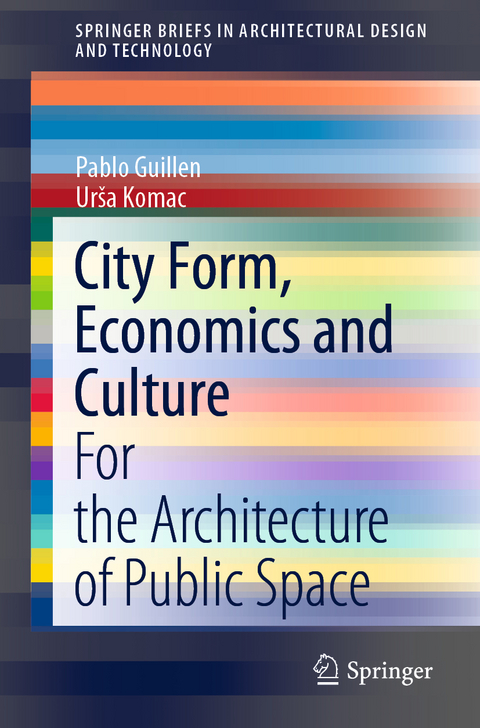
City Form, Economics and Culture
Springer Verlag, Singapore
978-981-15-5739-2 (ISBN)
This is a book about how cities occupy space. We are not interested in architectural masterpieces, but the tools for reinventing city life. We try to provide a framework for the architecture and design of public space without aesthetic considerations. We identify several defining factors. First of all, history as the city today very much depends on how it was yesterday. The geographical location and the technology available at a point of time both play a constraining role in what can be done as well. Culture, in the form of social norms, laws and regulations, also restricts what is possible to do. On the other hand, culture is also important in guiding the ideas and aspirations that together inform what society wants the city to be. The city needs government intervention, or regulation, to ameliorate the problem posed by a tangle of externalities and public goods. We focus on two comparative case studies: the evolution of urban form in the US and how it stands in a sharp contrast withthe evolution of urban form in Japan. We emphasise the difference in regulations between both jurisdictions. We study how differences in technological choices driven by culture (i.e. racial segregation), geography (i.e. the availability of land) and history (i.e. the mobility restrictions of the Tokugawa period) result in vast differences in mobility regarding the share of public transport, walking and cycling versus motorised private transport. American cities are constrained by rules that are much further from the neoliberal economic idea of free and competitive markets than the Japanese ones. Japanese planning promotes competition and through a granular, walkable city dotted with small shops, fosters variety in the availability of goods and services. We hypothesise how changing regulations could change the urban form to generate a greater variety of goods and to foster the access to those goods through a more equitable distribution of wealth. Critically, we point out that a desirably denser city must rely on public transport, and we also study how a less-dense city can be made to work with public transport. We conclude by claiming that changes in regulations are very unlikely to happen in the US, as it would require deep cultural changes to move from local to a more universal and less excluding public good provision, but they are both possible and desirable in other jurisdictions.
Associate Professor Pablo Guillen works at the School of Economics of the University of Sydney in Australia. He holds a PhD from the Autonomous University of Barcelona and spent two years as a post-doctoral fellow at Harvard Business School. His research deals with experimental and behavioural economics, focusing on market design and bounded rationality. He is co-author of the book “La caja de memoria de Bogdan Bogdanovic” (with Ursa Komac). Ursa Komac is a Senior Lecturer in Architectural Design and Technology and the Director of Academic Programs in Architecture at the Western Sydney University. Her research deals with architecture and the city, with a focus on public space and heritage. She holds a PhD from Universitat Politecnica de Catalunya, Barcelona. She published a book on Bogdan Bogdanovic (joint with Pablo Guillen). Recently she was a Visiting Research Fellow at Tokyo University of the Arts.
Introduction.- Why cities exist?- Cities are more important than ever.- Public goods, externalities and the city.- Governing for the public good: the problem of city governance and planning.- Growth and shape of the pre-industrial city.- The raise of the rail-based mechanical city.- Motorisation and the city: America leads the world.- The Japanese experience: the raise of the minimal car use megalopolis.- Following America, not Japan: car dependent emerging megacities.- Motorisation and de-motorisation in Europe.- Conclusions.
| Erscheinungsdatum | 15.06.2020 |
|---|---|
| Reihe/Serie | SpringerBriefs in Architectural Design and Technology |
| Zusatzinfo | 12 Illustrations, color; 9 Illustrations, black and white; VI, 81 p. 21 illus., 12 illus. in color. |
| Verlagsort | Singapore |
| Sprache | englisch |
| Maße | 155 x 235 mm |
| Themenwelt | Naturwissenschaften ► Biologie ► Ökologie / Naturschutz |
| Naturwissenschaften ► Geowissenschaften ► Geografie / Kartografie | |
| Sozialwissenschaften ► Soziologie ► Spezielle Soziologien | |
| Technik ► Bauwesen | |
| Schlagworte | Cities of Tomorrow • Image Architecture • Leave Me Alone Space • New Urbanism • Public Space and City • Public Space Architecture • Suburbia • Together Space • Urban Designers |
| ISBN-10 | 981-15-5739-X / 981155739X |
| ISBN-13 | 978-981-15-5739-2 / 9789811557392 |
| Zustand | Neuware |
| Informationen gemäß Produktsicherheitsverordnung (GPSR) | |
| Haben Sie eine Frage zum Produkt? |
aus dem Bereich


